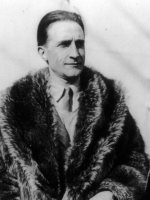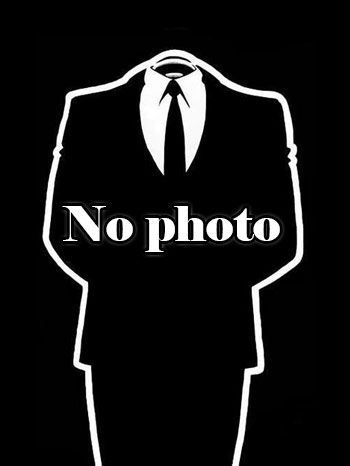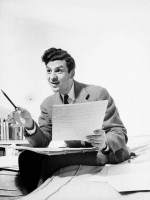Man Ray is a Actor, Director, Scriptwriter, Producer, Assistant Director, Director of Photography, Editor and Cinematography American born on 27 august 1890 at Philadelphia (USA)
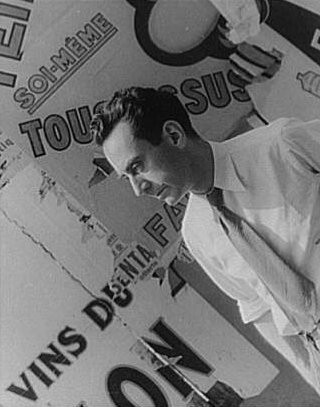
Man Ray, pseudonyme d’Emmanuel Radnitsky, est un peintre, photographe et réalisateur de cinéma américain né le 27 août 1890 à Philadelphie (États-Unis) et mort le 18 novembre 1976 à Paris (France).
Acteur du dadaïsme à New York, puis du surréalisme à Paris, Man Ray a perfectionné la technique du photogramme de Christian Schad et inventé le procédé dit de solarisation avec l'aide de la photographe Lee Miller.
Il fréquente la Modern School du Ferrer Center qui fonctionne à Manhattan puis Harlem selon les principes de l'éducateur libertaire catalan Francisco Ferrer. Formation anarchiste déterminante, puisqu'elle le libère très tôt du respect des valeurs établies, désacralise à ses yeux les techniques d'expression traditionnelles et l'encourage à ne suivre que sa propre nécessité individuelle dans toutes ses innovations.
Refusant toute hiérarchie entre la peinture et la photographie, il considère la caméra et le pinceau comme des instruments équivalents à ce qu'est la machine à écrire pour un écrivain.
New York
Sa carrière commence à New York. Avec son ami proche Marcel Duchamp, ils forment la branche américaine du mouvement dada. Après quelques expériences artistiques infructueuses, notamment une publication sur le dada new-yorkais en 1920, Man Ray conclut que « Dada ne peut pas vivre à New York ».
Paris
Le 14 juillet 1921, Man Ray débarque au Havre (Seine-Maritime), puis arrive à Paris, à la gare Saint-Lazare, où Marcel Duchamp l'accueille.
Le soir même, il est présenté aux surréalistes Louis Aragon, André Breton, Paul Éluard et Gala, Théodore Fraenkel, Jacques Rigaut et Philippe Soupault. Il s'installe dans le quartier du Montparnasse, rencontre et tombe amoureux de la chanteuse française et modèle Kiki de Montparnasse.
Il fréquente les bals des Beaumont ainsi que des cabarets, dont le Bœuf sur le Toit et le Jockey.
Il rencontre également le couturier Paul Poiret. Il réalise de nombreuses photos de mode qui sont publiées dans les magazines et contribuent à le faire connaître. À son grand regret, il n'aura jamais l'occasion de faire le portrait du couturier. Dans son livre de souvenirs, il confie qu'à la mort de Paul Poiret il a envoyé à un journal une photo du médecin personnel du couturier comme étant un portrait de Poiret et que cette photo a été publiée comme telle. En 1922, l'agent de Marcel Duchamp, Pierre Roché, un ami rencontré en novembre 1916 à New York qui a fait travailler avant guerre Hélène Perdriat pour Paul Poiret et qui est un intime de Marie Laurencin, l'amante de la sœur du couturier, Nicole Groult, lui prête l'argent pour ouvrir un studio de photographie. En échange, il y développe les photographies érotiques des uns et des autres, telle celle d'Hélène Hessel se déshabillant sur la plage.
Avec Jean Arp, Max Ernst, André Masson, Joan Miró et Pablo Picasso, il présente ses œuvres à la première exposition surréaliste de la galerie Pierre à Paris en 1925.
Ami de Marie-Laure de Noailles et de Charles, vicomte de Noailles, il tourne en 1928 à Hyères à la Villa Noailles son troisième film Les Mystères du château de Dé.
En 1929, il commence à travailler avec Lee Miller qui, en plus d'être sa muse et son assistante, devient sa maîtresse. Jusqu'en 1932, ils entretiennent cette relation créative, développant ensemble le potentiel esthétique de la solarisation.
À Montparnasse, durant vingt ans, Man Ray révolutionne l'art photographique. Les grands artistes de son temps posent sous son objectif, comme James Joyce, Gertrude Stein ou Jean Cocteau. Il contribue à valoriser l'œuvre d'Eugène Atget qu'il fait découvrir aux surréalistes et à son assistante Berenice Abbott. Avec le groupe surréaliste, il participe d'octobre à novembre 1933 au 6e Salon des surindépendants.
En 1934, Meret Oppenheim pose pour Man Ray, cette série de photographies de nus devient l'une de ses séries les plus célèbres.
En 1936, il fait la connaissance d'Adrienne Fidelin. Il a 46 ans et elle presque 20. Elle devient son amante, son modèle et sa muse. Inséparables, Man Ray l'introduit dans son cercle d'amis artistes et écrivains, adeptes du surréalisme, mouvement alors en vogue. Dans son autobiographie, Man Ray décrit le groupe constitué par Pablo Picasso, Dora Maar, Paul Éluard et son épouse Nusch, Max Ernst et Leonora Carrington, ainsi que Lee Miller et Roland Penrose, André Breton. C'est ainsi le début d'une histoire d'amour étroitement mêlée à une vie artistique intense, au sein de la communauté surréaliste. Elle prend alors le nom d'Ady Fidelin. C'est l'une des membres les plus fascinants de l’avant-garde internationale.
Hollywood
En 1940, après la défaite de la France, Man Ray parvient à rejoindre Lisbonne et s'embarque pour les États-Unis en compagnie de Salvador et Gala Dalí et du cinéaste René Clair. Après quelques jours passés à New York, il gagne la côte ouest avec le projet de quitter le pays pour Tahiti où il resterait quelques années. Arrivé à Hollywood, il reçoit des propositions d'exposition, rencontre sa deuxième femme, Juliet, et décide de se remettre à peindre.
Retour à Paris
En 1951, il revient à Paris, et habita par la suite à l'hôtel Istria, au 31 bis, rue Campagne-Première.
Il devient satrape du Collège de 'Pataphysique en 1963.
Il meurt à Paris le 18 novembre 1976 et est inhumé au cimetière du Montparnasse (7e division). Sa tombe porte l'épitaphe : « Unconcerned, but not indifferent » (« Détaché, mais pas indifférent »).
Man Ray photographié par Lothar Wolleh à Paris en 1975.
La tombe de Man Ray à Paris au cimetière du Montparnasse : « Unconcerned, but not indifferent ».
Entre le 18 et le 25 mars 2019, la tombe de Man Ray a été profanée à cinq reprises. Le médaillon représentant le couple a été brisé et la stèle de son épouse Juliet Man Ray, née Browner (1911-1991) a été détruite.
Source : Wikidata
Man Ray

Birth name Emmanuel Radnitsky
Nationality USA
Birth 27 august 1890 at Philadelphia (USA)
Death 18 november 1976 (at 86 years) at Paris (France)
Nationality USA
Birth 27 august 1890 at Philadelphia (USA)
Death 18 november 1976 (at 86 years) at Paris (France)
Acteur du dadaïsme à New York, puis du surréalisme à Paris, Man Ray a perfectionné la technique du photogramme de Christian Schad et inventé le procédé dit de solarisation avec l'aide de la photographe Lee Miller.
Biography
Né en 1890 à Philadelphie, Emmanuel Radnitsky dit Man Ray passe sa jeunesse à Brooklyn.Il fréquente la Modern School du Ferrer Center qui fonctionne à Manhattan puis Harlem selon les principes de l'éducateur libertaire catalan Francisco Ferrer. Formation anarchiste déterminante, puisqu'elle le libère très tôt du respect des valeurs établies, désacralise à ses yeux les techniques d'expression traditionnelles et l'encourage à ne suivre que sa propre nécessité individuelle dans toutes ses innovations.
Refusant toute hiérarchie entre la peinture et la photographie, il considère la caméra et le pinceau comme des instruments équivalents à ce qu'est la machine à écrire pour un écrivain.
New York
Sa carrière commence à New York. Avec son ami proche Marcel Duchamp, ils forment la branche américaine du mouvement dada. Après quelques expériences artistiques infructueuses, notamment une publication sur le dada new-yorkais en 1920, Man Ray conclut que « Dada ne peut pas vivre à New York ».
Paris
Le 14 juillet 1921, Man Ray débarque au Havre (Seine-Maritime), puis arrive à Paris, à la gare Saint-Lazare, où Marcel Duchamp l'accueille.
Le soir même, il est présenté aux surréalistes Louis Aragon, André Breton, Paul Éluard et Gala, Théodore Fraenkel, Jacques Rigaut et Philippe Soupault. Il s'installe dans le quartier du Montparnasse, rencontre et tombe amoureux de la chanteuse française et modèle Kiki de Montparnasse.
Il fréquente les bals des Beaumont ainsi que des cabarets, dont le Bœuf sur le Toit et le Jockey.
Il rencontre également le couturier Paul Poiret. Il réalise de nombreuses photos de mode qui sont publiées dans les magazines et contribuent à le faire connaître. À son grand regret, il n'aura jamais l'occasion de faire le portrait du couturier. Dans son livre de souvenirs, il confie qu'à la mort de Paul Poiret il a envoyé à un journal une photo du médecin personnel du couturier comme étant un portrait de Poiret et que cette photo a été publiée comme telle. En 1922, l'agent de Marcel Duchamp, Pierre Roché, un ami rencontré en novembre 1916 à New York qui a fait travailler avant guerre Hélène Perdriat pour Paul Poiret et qui est un intime de Marie Laurencin, l'amante de la sœur du couturier, Nicole Groult, lui prête l'argent pour ouvrir un studio de photographie. En échange, il y développe les photographies érotiques des uns et des autres, telle celle d'Hélène Hessel se déshabillant sur la plage.
Avec Jean Arp, Max Ernst, André Masson, Joan Miró et Pablo Picasso, il présente ses œuvres à la première exposition surréaliste de la galerie Pierre à Paris en 1925.
Ami de Marie-Laure de Noailles et de Charles, vicomte de Noailles, il tourne en 1928 à Hyères à la Villa Noailles son troisième film Les Mystères du château de Dé.
En 1929, il commence à travailler avec Lee Miller qui, en plus d'être sa muse et son assistante, devient sa maîtresse. Jusqu'en 1932, ils entretiennent cette relation créative, développant ensemble le potentiel esthétique de la solarisation.
À Montparnasse, durant vingt ans, Man Ray révolutionne l'art photographique. Les grands artistes de son temps posent sous son objectif, comme James Joyce, Gertrude Stein ou Jean Cocteau. Il contribue à valoriser l'œuvre d'Eugène Atget qu'il fait découvrir aux surréalistes et à son assistante Berenice Abbott. Avec le groupe surréaliste, il participe d'octobre à novembre 1933 au 6e Salon des surindépendants.
En 1934, Meret Oppenheim pose pour Man Ray, cette série de photographies de nus devient l'une de ses séries les plus célèbres.
En 1936, il fait la connaissance d'Adrienne Fidelin. Il a 46 ans et elle presque 20. Elle devient son amante, son modèle et sa muse. Inséparables, Man Ray l'introduit dans son cercle d'amis artistes et écrivains, adeptes du surréalisme, mouvement alors en vogue. Dans son autobiographie, Man Ray décrit le groupe constitué par Pablo Picasso, Dora Maar, Paul Éluard et son épouse Nusch, Max Ernst et Leonora Carrington, ainsi que Lee Miller et Roland Penrose, André Breton. C'est ainsi le début d'une histoire d'amour étroitement mêlée à une vie artistique intense, au sein de la communauté surréaliste. Elle prend alors le nom d'Ady Fidelin. C'est l'une des membres les plus fascinants de l’avant-garde internationale.
Hollywood
En 1940, après la défaite de la France, Man Ray parvient à rejoindre Lisbonne et s'embarque pour les États-Unis en compagnie de Salvador et Gala Dalí et du cinéaste René Clair. Après quelques jours passés à New York, il gagne la côte ouest avec le projet de quitter le pays pour Tahiti où il resterait quelques années. Arrivé à Hollywood, il reçoit des propositions d'exposition, rencontre sa deuxième femme, Juliet, et décide de se remettre à peindre.
Retour à Paris
En 1951, il revient à Paris, et habita par la suite à l'hôtel Istria, au 31 bis, rue Campagne-Première.
Il devient satrape du Collège de 'Pataphysique en 1963.
Il meurt à Paris le 18 novembre 1976 et est inhumé au cimetière du Montparnasse (7e division). Sa tombe porte l'épitaphe : « Unconcerned, but not indifferent » (« Détaché, mais pas indifférent »).
Man Ray photographié par Lothar Wolleh à Paris en 1975.
La tombe de Man Ray à Paris au cimetière du Montparnasse : « Unconcerned, but not indifferent ».
Entre le 18 et le 25 mars 2019, la tombe de Man Ray a été profanée à cinq reprises. Le médaillon représentant le couple a été brisé et la stèle de son épouse Juliet Man Ray, née Browner (1911-1991) a été détruite.
Usually with
Filmography of Man Ray (9 films)
Actor
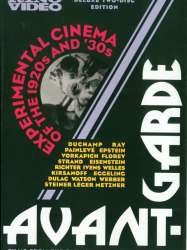 , 27minutes
, 27minutesDirected by Man Ray
Genres Drama, Documentary
Actors Man Ray, Georges Auric, Henri d'Ursel
Roles Self
Rating62%





To the Viscountess of Noailles. I dedicate these pictures which can never reveal the extent of her kindness and charm. How two travellers arrived in St. Bernard, what they saw in the ruins of an old castle on top of which a modern-time castle stands. The travellers: MAN RAY, J.-A. Boiffard.
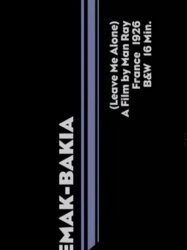
Emak-Bakia (1926)
, 19minutesDirected by Man Ray
Origin France
Genres Documentary
Actors Kiki de Montparnasse, Man Ray
Rating68%





Emak-Bakia shows elements of fluid mechanical motion in parts, rotating artifacts showing his ideas of everyday objects being extended and rendered useless. Kiki of Montparnasse (Alice Prin) is shown driving a car in a scene through a town. Towards the middle of the film Jacques Rigaut appears dressed in female clothing and make-up. Later in the film a caption appears: "La raison de cette extravagance" (the reason for this extravagance). The film then cuts to a car arriving and a passenger leaving with briefcase entering a building, opening the case revealing men's shirt collars which he proceeds to tear in half. The collars are then used as a focus for the film, rotating through double exposures.

Entr'acte (1924)
, 22minutesDirected by René Clair, Georges Lacombe
Origin France
Genres Comedy, Fantasy
Themes Dance films
Actors Marcel Achard, Man Ray, Marcel Duchamp, Georges Lacombe, Kiki de Montparnasse, Roger Le Bon
Roles Chess player, white set
Rating72%





Le film est une suite de scènes « surréalistes », comme celle de la poursuite folle d'un corbillard ou de la danseuse barbue filmée en contre-plongée.
Director
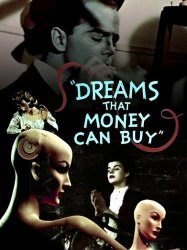
Dreams That Money Can Buy (1947)
, 1h39Directed by Man Ray, Hans Richter (artiste), Marcel Duchamp
Origin USA
Genres Drama, Fantasy
Actors Libby Holman, Stanley Kubrick, Louis Applebaum, Ruth Sobotka
Rating66%





Joe/Narcissus (Jack Bittner) is an ordinary man who has recently signed a complicated lease on a room. As he wonders how to pay the rent, he discovers that he can see the contents of his mind unfolding whilst looking into his eyes in the mirror. He realises that he can apply his gift to others ("If you can look inside yourself, you can look inside anyone!"), and sets up a business in his room, selling tailor-made dreams to a variety of frustrated and neurotic clients. Each of the seven surreal dream sequences in the diegesis is in fact the creation of a contemporary avant-garde and/or surrealist artist, as follows:
 , 27minutes
, 27minutesDirected by Man Ray
Genres Drama, Documentary
Actors Man Ray, Georges Auric, Henri d'Ursel
Rating62%





To the Viscountess of Noailles. I dedicate these pictures which can never reveal the extent of her kindness and charm. How two travellers arrived in St. Bernard, what they saw in the ruins of an old castle on top of which a modern-time castle stands. The travellers: MAN RAY, J.-A. Boiffard.
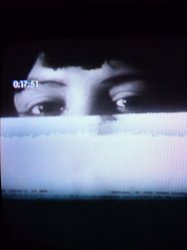
The Starfish (1928)
, 17minutesDirected by Man Ray
Origin France
Genres Drama, Romance
Actors Kiki de Montparnasse
Rating69%





Almost all of the scenes in this film are shot either off a mirror like the final shot, or through diffused and textured glass.

Emak-Bakia (1926)
, 19minutesDirected by Man Ray
Origin France
Genres Documentary
Actors Kiki de Montparnasse, Man Ray
Rating68%





Emak-Bakia shows elements of fluid mechanical motion in parts, rotating artifacts showing his ideas of everyday objects being extended and rendered useless. Kiki of Montparnasse (Alice Prin) is shown driving a car in a scene through a town. Towards the middle of the film Jacques Rigaut appears dressed in female clothing and make-up. Later in the film a caption appears: "La raison de cette extravagance" (the reason for this extravagance). The film then cuts to a car arriving and a passenger leaving with briefcase entering a building, opening the case revealing men's shirt collars which he proceeds to tear in half. The collars are then used as a focus for the film, rotating through double exposures.
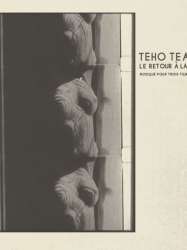
Return to Reason (1923)
, 3minutesDirected by Man Ray
Origin France
Genres Drama
Rating63%





Film expérimental, des taches et des formes blanches qui tournent sur un fond noir, le torse rayé de Kiki de Montparnasse (Alice Prin), une boîte à œufs qui tourne. L'un des premiers films dadaïstes.
Scriptwriter

Dreams That Money Can Buy (1947)
, 1h39Directed by Man Ray, Hans Richter (artiste), Marcel Duchamp
Origin USA
Genres Drama, Fantasy
Actors Libby Holman, Stanley Kubrick, Louis Applebaum, Ruth Sobotka
Roles Story
Rating66%





Joe/Narcissus (Jack Bittner) is an ordinary man who has recently signed a complicated lease on a room. As he wonders how to pay the rent, he discovers that he can see the contents of his mind unfolding whilst looking into his eyes in the mirror. He realises that he can apply his gift to others ("If you can look inside yourself, you can look inside anyone!"), and sets up a business in his room, selling tailor-made dreams to a variety of frustrated and neurotic clients. Each of the seven surreal dream sequences in the diegesis is in fact the creation of a contemporary avant-garde and/or surrealist artist, as follows:
 , 27minutes
, 27minutesDirected by Man Ray
Genres Drama, Documentary
Actors Man Ray, Georges Auric, Henri d'Ursel
Rating62%





To the Viscountess of Noailles. I dedicate these pictures which can never reveal the extent of her kindness and charm. How two travellers arrived in St. Bernard, what they saw in the ruins of an old castle on top of which a modern-time castle stands. The travellers: MAN RAY, J.-A. Boiffard.

Emak-Bakia (1926)
, 19minutesDirected by Man Ray
Origin France
Genres Documentary
Actors Kiki de Montparnasse, Man Ray
Roles Writer
Rating68%





Emak-Bakia shows elements of fluid mechanical motion in parts, rotating artifacts showing his ideas of everyday objects being extended and rendered useless. Kiki of Montparnasse (Alice Prin) is shown driving a car in a scene through a town. Towards the middle of the film Jacques Rigaut appears dressed in female clothing and make-up. Later in the film a caption appears: "La raison de cette extravagance" (the reason for this extravagance). The film then cuts to a car arriving and a passenger leaving with briefcase entering a building, opening the case revealing men's shirt collars which he proceeds to tear in half. The collars are then used as a focus for the film, rotating through double exposures.
Producer

The Starfish (1928)
, 17minutesDirected by Man Ray
Origin France
Genres Drama, Romance
Actors Kiki de Montparnasse
Roles Producer
Rating69%





Almost all of the scenes in this film are shot either off a mirror like the final shot, or through diffused and textured glass.

Emak-Bakia (1926)
, 19minutesDirected by Man Ray
Origin France
Genres Documentary
Actors Kiki de Montparnasse, Man Ray
Roles Producer
Rating68%





Emak-Bakia shows elements of fluid mechanical motion in parts, rotating artifacts showing his ideas of everyday objects being extended and rendered useless. Kiki of Montparnasse (Alice Prin) is shown driving a car in a scene through a town. Towards the middle of the film Jacques Rigaut appears dressed in female clothing and make-up. Later in the film a caption appears: "La raison de cette extravagance" (the reason for this extravagance). The film then cuts to a car arriving and a passenger leaving with briefcase entering a building, opening the case revealing men's shirt collars which he proceeds to tear in half. The collars are then used as a focus for the film, rotating through double exposures.

Return to Reason (1923)
, 3minutesDirected by Man Ray
Origin France
Genres Drama
Roles Producer
Rating63%





Film expérimental, des taches et des formes blanches qui tournent sur un fond noir, le torse rayé de Kiki de Montparnasse (Alice Prin), une boîte à œufs qui tourne. L'un des premiers films dadaïstes.
Director
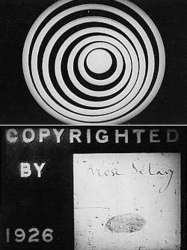
Anemic Cinema (1926)
Directed by Marcel Duchamp
Genres Drama, Documentary
Roles Assistant Director
Rating60%





 Connection
Connection

